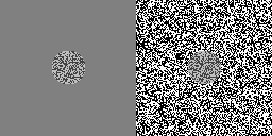
The visual cortex of the brain is the area of the cerebral cortex that processes visual information. It is located in the occipital lobe. Sensory input originating from the eyes travels through the lateral geniculate nucleus in the thalamus and then reaches the visual cortex. The area of the visual cortex that receives the sensory input from the lateral geniculate nucleus is the primary visual cortex, also known as visual area 1 (V1), Brodmann area 17, or the striate cortex. The extrastriate areas consist of visual areas 2, 3, 4, and 5.

The visual system is the physiological basis of visual perception. The system detects, transduces and interprets information concerning light within the visible range to construct an image and build a mental model of the surrounding environment. The visual system is associated with the eye and functionally divided into the optical system and the neural system.

Amblyopia, also called lazy eye, is a disorder of sight in which the brain fails to fully process input from one eye and over time favors the other eye. It results in decreased vision in an eye that typically appears normal in other aspects. Amblyopia is the most common cause of decreased vision in a single eye among children and younger adults.
Stereopsis is the component of depth perception retrieved by means of binocular disparity through binocular vision. It is not the only contributor to depth perception, but it is a major one. Binocular vision occurs because each eye receives a different image due to their slightly different positions in one's head. These positional differences are referred to as "horizontal disparities" or, more generally, "binocular disparities". Disparities are processed in the visual cortex of the brain to yield depth perception. While binocular disparities are naturally present when viewing a real three-dimensional scene with two eyes, they can also be simulated by artificially presenting two different images separately to each eye using a method called stereoscopy. The perception of depth in such cases is also referred to as "stereoscopic depth".

Fixation disparity is a tendency of the eyes to drift in the direction of the heterophoria. While the heterophoria refers to a fusion-free vergence state, the fixation disparity refers to a small misalignment of the visual axes when both eyes are open in an observer with normal fusion and binocular vision. The misalignment may be vertical, horizontal or both. The misalignment is much smaller than that of strabismus. While strabismus prevents binocular vision, fixation disparity keeps binocular vision, however it may reduce a patient's level of stereopsis. A patient may or may not have fixation disparity and a patient may have a different fixation disparity at distance than near. Observers with a fixation disparity are more likely to report eye strain in demanding visual tasks; therefore, tests of fixation disparity belong to the diagnostic tools used by eye care professionals: remediation includes vision therapy, prism eye glasses, or visual ergonomics at the workplace.
Visual search is a type of perceptual task requiring attention that typically involves an active scan of the visual environment for a particular object or feature among other objects or features. Visual search can take place with or without eye movements. The ability to consciously locate an object or target amongst a complex array of stimuli has been extensively studied over the past 40 years. Practical examples of using visual search can be seen in everyday life, such as when one is picking out a product on a supermarket shelf, when animals are searching for food among piles of leaves, when trying to find a friend in a large crowd of people, or simply when playing visual search games such as Where's Wally?
The Stiles–Crawford effect is a property of the human eye that refers to the directional sensitivity of the cone photoreceptors.

The flash lag illusion or flash-lag effect is a visual illusion wherein a flash and a moving object that appear in the same location are perceived to be displaced from one another. Several explanations for this simple illusion have been explored in the neuroscience literature.

The Chubb illusion is an optical illusion or error in visual perception in which the apparent contrast of an object varies substantially to most viewers depending on its relative contrast to the field on which it is displayed. These visual illusions are of particular interest to researchers because they may provide valuable insights in regard to the workings of human visual systems.
Within computer technology, the gaze-contingency paradigm is a general term for techniques allowing a computer screen display to change in function depending on where the viewer is looking. Gaze-contingent techniques are part of the eye movement field of study in psychology.

In behavioral biology, the optomotor response is an innate, orienting behavior evoked by whole-field visual motion and is common to fish and insects during locomotion, such as swimming, walking and flying. The optomotor response has algorithmic properties such that the direction of the whole-field coherent motion dictates the direction of the behavioral output. For instance, when zebrafish larvae are presented with a sinusoidal black and white grating pattern, the larvae will turn and swim in the direction of the perceived motion.
Perceptual learning is learning better perception skills such as differentiating two musical tones from one another or categorizations of spatial and temporal patterns relevant to real-world expertise. Examples of this may include reading, seeing relations among chess pieces, and knowing whether or not an X-ray image shows a tumor.

Visual processing abnormalities in schizophrenia are commonly found, and contribute to poor social function.

Crowding is a perceptual phenomenon where the recognition of objects presented away from the fovea is impaired by the presence of other neighbouring objects. It has been suggested that crowding occurs due to mandatory integration of the crowded objects by a texture-processing neural mechanism, but there are several competing theories about the underlying mechanisms. It is considered a kind of grouping since it is "a form of integration over space as target features are spuriously combined with flanker features."
Surround suppression is where the relative firing rate of a neuron may under certain conditions decrease when a particular stimulus is enlarged. It has been observed in electrophysiology studies of the brain and has been noted in many sensory neurons, most notably in the early visual system. Surround suppression is defined as a reduction in the activity of a neuron in response to a stimulus outside its classical receptive field.
Cerebral diplopia or polyopia describes seeing two or more images arranged in ordered rows, columns, or diagonals after fixation on a stimulus. The polyopic images occur monocular bilaterally and binocularly, differentiating it from ocular diplopia or polyopia. The number of duplicated images can range from one to hundreds. Some patients report difficulty in distinguishing the replicated images from the real images, while others report that the false images differ in size, intensity, or color. Cerebral polyopia is sometimes confused with palinopsia, in which multiple images appear while watching an object. However, in cerebral polyopia, the duplicated images are of a stationary object which are perceived even after the object is removed from the visual field. Movement of the original object causes all of the duplicated images to move, or the polyopic images disappear during motion. In palinoptic polyopia, movement causes each polyopic image to leave an image in its wake, creating hundreds of persistent images (entomopia).
Binocular switch suppression (BSS) is a technique to suppress usually salient images from an individual's awareness, a type of experimental manipulation used in visual perception and cognitive neuroscience. In BSS, two images of differing signal strengths are repetitively switched between the left and right eye at a constant rate of 1 Hertz. During this process of switching, the image of lower contrast and signal strength is perceptually suppressed for a period of time.
In psychology and neuroscience, multiple object tracking (MOT) refers to the ability of humans and other animals to simultaneously monitor multiple objects as they move. It is also the term for certain laboratory techniques used to study this ability.
Ensemble coding, also known as ensemble perception or summary representation, is a theory in cognitive neuroscience about the internal representation of groups of objects in the human mind. Ensemble coding proposes that such information is recorded via summary statistics, particularly the average or variance. Experimental evidence tends to support the theory for low-level visual information, such as shapes and sizes, as well as some high-level features such as face gender. Nonetheless, it remains unclear the extent to which ensemble coding applies to high-level or non-visual stimuli, and the theory remains the subject of active research.

Roland William Fleming, FRSB is a British and German interdisciplinary researcher specializing in the visual perception of objects and materials. He is the Kurt Koffka Professor of Experimental Psychology at Justus Liebig University of Giessen. and the Executive Director of the Center for Mind, Brain and Behavior of the Universities of Marburg and Giessen. He is also co-Spokesperson for the Research Cluster “The Adaptive Mind”.










